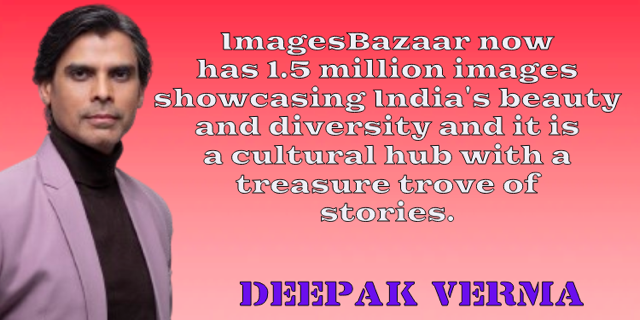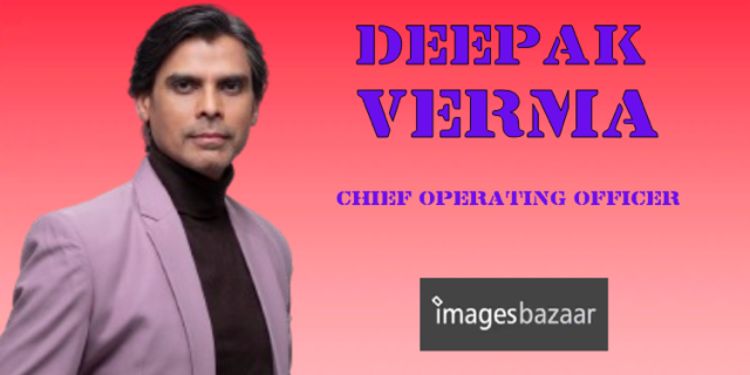Deepak Verma forayed into the stock image industry in 2005 with the launch of ImagesBazaar. He is now COO.
His role at ImagesBazaar involves staying abreast of industry trends, introducing fresh insights to the work, identifying new opportunities, and expanding stock image collection to cater to diverse subjects and styles while navigating the challenges posed by increased competition and changing consumer behaviours.
Under his leadership, today ImagesBazaar has over 10+ Lakh images and videos and catering to more than 7000 clients in 45+ countries. ImagesBazaar said that in the last four years, it has grown by more than 4000% in terms of revenue and is planning to hit Rs.25 crore profit this year.
The state of the stock images market is expected to exhibit a CAGR of 6.8 from 2023 to 2032. Medianews4U.com caught up with ImagesBazaar, COO – Deepak Verma to find out more.
Q. How did the idea of founding Imagesbazaar come up back in 2006?
Back in 2006, while working on his website, Sandeep Maheshwari ran into a challenging problem: he couldn’t find good stock photos that truly captured the essence of India. The available options simply weren’t adequate. Instead of grumbling about it, he decided to take action.
That’s when the idea for ImagesBazaar struck him: a platform that would provide high-quality, culturally relevant images tailored to the Indian market. Starting with a few images, Sandeep’s vision quickly grew into something much larger. ImagesBazaar now has 1.5 million images showcasing India’s beauty and diversity.
However, getting there was no easy task. Sandeep poured his heart and soul into the project, motivated by his passion for innovation and love of everything Indian. Each click of the camera felt like capturing a piece of India’s soul—its colours, traditions, and people.
ImagesBazaar has evolved into more than just a website; it is now a cultural hub, a treasure trove of images that tell a million stories. It demonstrates Sandeep’s entrepreneurial spirit and unwavering belief in the power of visual storytelling. ImagesBazaar has grown from humble beginnings to global reach, continuing to change the game, one stunning image at a time.
Q. To what extent has the market for stock photography grown over the years?
The stock photography scene has grown significantly over the years. The images appear everywhere, from advertisements to websites to social media. The reason behind that is the internet taking over our lives and digital marketing ruling the field, having eye-catching visuals has become a necessity. Imagine you’re scrolling through your feed—the thing that catches your attention is the eye-catching images that stop on a reel/post. This is where stock photography proves to be helpful. It’s like having a bank of ready-made images at your disposal, ideal for any project you’re working on.
And as more people prioritise visual content, the stock photography industry is booming, generating impressive revenue and gaining a larger market share. As the saying goes, a picture is worth a thousand words, and in today’s digital landscape, it’s even more valuable.

Q. What role does stock photography play in ad campaigns?
Stock photography is essential for ad campaigns, providing a foundation for advertisers looking for cost-effective solutions without sacrificing quality. Its significance stems from its ability to provide a diverse array of high-quality images suitable for a wide range of advertising mediums, from traditional print materials to the vast expanse of online platforms. By utilizing stock photography, advertisers avoid the high costs associated with organising photoshoots, instead opting for a vast reservoir of pre-existing imagery that is perfectly aligned with their brand ethos and target demographic.
Stock photography assists advertisers in accelerating the creative process by quickly identifying images that match their campaign’s goals and aesthetic. This saves time and allows advertisers to easily tweak their ideas, resulting in more effective campaigns.
Basically, stock photography is critical for advertising. It helps you create eye-catching visuals while saving time and money. Including it in ad campaigns ensures that advertisers can always deliver powerful messages to their audiences.
Q. Could you talk about some of the companies that use your images?
ImagesBazaar has a diverse customer base, spanning industries such as advertising, marketing, e-commerce, and publishing. Coca-Cola, Pepsi, Nokia, LG, Samsung, and Honda, among others, have used ImagesBazaar’s extensive library of Indian images for advertising and marketing purposes. These leading companies choose ImagesBazaar because of its unique and diverse collection, which is perfectly tailored to resonate with their target audiences.
The appeal stems from ImagesBazaar’s ability to provide a unique glimpse into Indian culture through a rich tapestry of visuals that effectively convey brand messages. ImagesBazaar showcases vibrant street scenes, traditional festivals, and modern cityscapes, capturing the essence of India in all its diversity. Companies can use these images , fostering a stronger sense of resonance and engagement.
ImagesBazaar is a go-to resource for businesses looking to infuse their campaigns with the vibrant spirit of India. Its extensive collection ensures that brands can find the ideal imagery to bring their vision to life, resulting in impactful marketing materials that leave a lasting impression on customers.
Q. What is your USP compared to companies; like Getty Images?
ImagesBazaar specialises in providing a large selection of Indian images that are specifically tailored to the needs of the Indian market. Our collection is diverse and unique, allowing customers to effectively communicate their brand message to their target audience. Getty Images, on the other hand, is widely recognized as one of the world’s largest stock photography providers, offering a diverse range of high-quality images, videos, and music.
Both companies excel in their own right and serve different markets based on their customers’ needs. ImagesBazaar primarily serves the Indian market with culturally relevant content, whereas Getty Images caters to a larger, international audience looking for diverse visual assets. Each company’s strength stems from its ability to meet the specific needs of its respective customer base, which ensures its continued industry leadership.

Q. For 2024 what goals have been set in terms of revenue, profit, client roster growth and what is the game plan to get there?
We meticulously analysed market trends, competitive landscapes, and financial forecasts to develop our 2024 objectives. Our strategic blueprint is built around several key pillars: First, we will broaden our customer base through targeted outreach and engagement initiatives. Second, we plan to improve product or service quality to meet and exceed changing consumer expectations. In addition, marketing efforts will be stepped up to increase brand visibility and attract new customers. Furthermore, optimising operational efficiencies and cost-effectiveness to ensure long-term growth. By aligning our efforts with these strategic priorities, we aim to strengthen our market position and drive revenue growth.
Q. Could you talk about the kinds and categories of photos that are in most demand at the moment?
Within the ever-changing stock photography industry, demand is subject to shifts in both market dynamics and emerging trends. While some categories—such as real people, beauty, fashion, health, education, lifestyle, business, and festival-related imagery—continue to be popular on social media and in advertising, there is also a steady demand for images that portray a range of human experiences, from work to play. Product photographers are essential to e-commerce businesses in order to effectively present their products, and pictures that capture the essence of food, nature, and technology are still popular with viewers in a variety of fields. In order to succeed in this competitive environment, photographers need to constantly monitor changing consumer preferences and attentively meet the constantly evolving needs of their clients to produce high-quality, timely content that appeals to their target audiences.
Q. What role are AR and VR playing in stock photography?
Augmented Reality (AR) and Virtual Reality (VR) are revolutionising the stock photography landscape by providing customers with immersive and interactive experiences. These cutting-edge technologies create a dynamic platform for users to interact with stock images, providing a preview of how they would appear in real-world scenarios.
AR improves the viewing experience by superimposing virtual images on the physical environment, allowing users to see stock photos in a situation. For example, an advertising agency can use AR to superimpose stock images onto real-world objects, giving a preview of how they will appear in an ad campaign. This capability enables clients to make informed decisions about image selection and placement, thereby increasing the effectiveness of their marketing strategies.
Similarly, VR transports users into virtual worlds where they can explore stock photos in a more immersive way. By wearing VR headsets, viewers can explore digital spaces adorned with stock imagery, gaining a better understanding of the photos’ context and potential applications. This immersive experience allows creative professionals to brainstorm ideas and envision compelling narratives, thereby improving the quality and impact of their visual content.
Furthermore, AR and VR technologies bridge the gap between imagination and reality, allowing users to interact with stock photos in new ways. Whether it’s visualising products in a simulated environment or experiencing virtual scenes firsthand, these immersive tools expand the possibilities for storytelling and engagement in the world of stock photography.
As AR and VR evolve, their integration into the stock photography industry has enormous potential for improving collaboration, creativity, and communication. By leveraging the power of these immersive technologies, photographers and clients can embark on a journey of exploration and innovation, influencing the future of visual storytelling in the digital age.

Q. How do you monitor the use of your images to ensure that it is always authorised for use?
We prioritise image protection by implementing a variety of measures to prevent unauthorised use. These safeguards include watermarking, in addition, we use image tracking technology to monitor where our images are used online, ensuring that they are only used with proper authorization and licensing.
Furthermore, we establish legal agreements with clients to ensure that our images are used exclusively in accordance with the agreed-upon terms and conditions. These agreements protect against unauthorised use and provide legal recourse in case of infringement.
In addition to proactive measures, we perform regular audits and checks to monitor the use of our images. This allows us to identify instances of unauthorised exploitation and take appropriate action to protect our intellectual property rights.
Overall, our commitment to image protection is steadfast, and we are constantly working to maintain the integrity of our content through comprehensive monitoring and enforcement measures.
Q. Can you please talk about the challenge of AI in terms of replicating photos?
About the difficulty AI faces in reproducing images, I would like to clarify that this ability depends on AI’s capacity to capture all the subtleties and details present in the original image. This covers a wide range of elements that affect the photograph’s aesthetic appeal, such as texture, colour, and lighting. Therefore, a distinct set of difficulties arises when AI can identify and replicate complex or abstract images. Even though AI technology has advanced significantly in the area of photography, there are still several obstacles and restrictions that need to be addressed.
Even with major progress, artificial intelligence is still unable to accurately replicate a wide range of visual compositions. This task is made more difficult by variations in textures, color schemes, and lighting. AI algorithm improvements and ongoing innovation are necessary to meet these challenges. Researchers and developers continually explore new ways to improve AI’s capacity to recognize and mimic the subtleties of various photographic subjects and styles.
Furthermore, there are more reasons than just technical to pursue the goal of enhancing AI’s photo replication skills. It also involves moral issues, like making sure AI systems respect individuals’ right to privacy and cultural sensitivities when duplicating images. We can strive toward realising AI’s full potential in the field of photography while reducing risks and concerns by approaching these issues comprehensively.

















